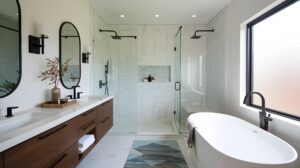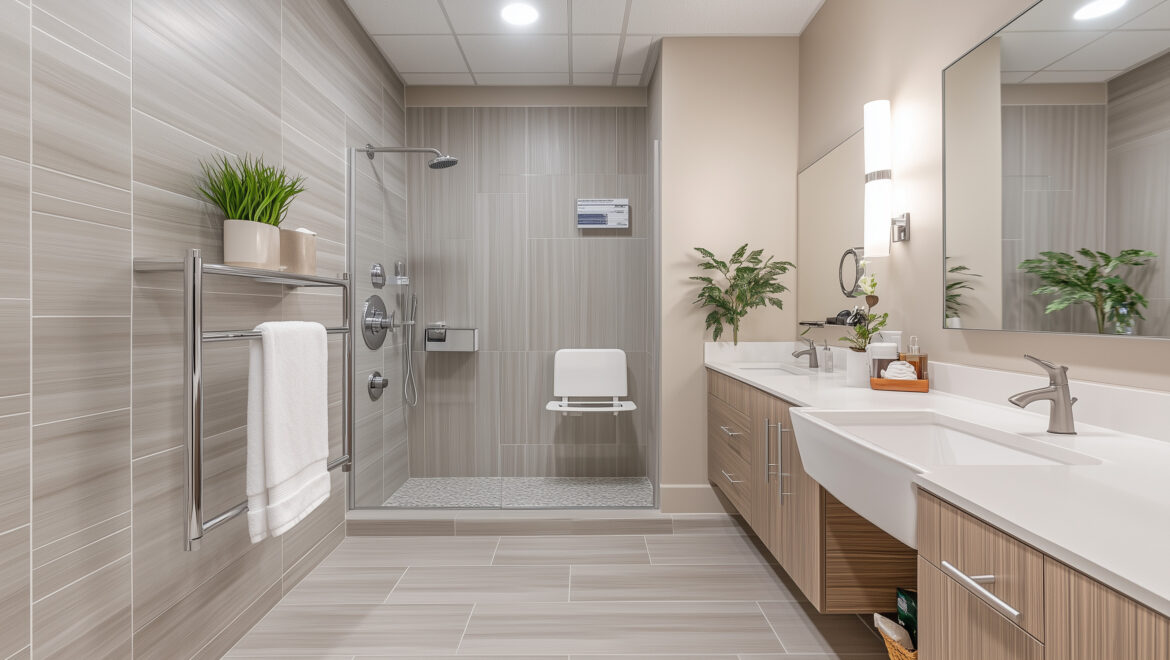Bathroom Remodeling in Massachusetts: Turn Your Outdated Bathroom Into a Luxury Retreat
If you’re searching for bathroom remodeling Massachusetts homeowners can truly rely on, Colony Home Improvement offers decades of craftsmanship, design expertise, and local know-how. Whether you’re updating an old colonial home in Newton, adding a second bath to your Cape-style house in Waltham, or creating a spa-like master suite in your Boston condo, our team brings your vision to life—on time and on budget.
Bathroom remodeling in Massachusetts isn’t just about new tile and fixtures. It’s about improving comfort, energy efficiency, and home value in a region where style meets practicality. From coastal humidity challenges to tight city layouts, our team understands the unique conditions of Massachusetts homes and tailors each project to fit your space, lifestyle, and local building codes.
Why Homeowners Across Massachusetts Choose Colony Home Improvement
Massachusetts homeowners have high standards when it comes to craftsmanship—and that’s why they trust Colony Home Improvement. Our company has built a reputation for excellence throughout the state by combining design expertise, licensed tradespeople, and meticulous project management.
Here’s what sets us apart:
-
Local Experience: We’ve completed hundreds of bathroom remodels across Massachusetts, from Cambridge and Belmont to Wellesley and Natick.
-
Comprehensive Service: Our design-build approach means you get one partner from concept through completion.
-
Quality Craftsmanship: Every project uses premium materials, reliable brands, and finishes built to last.
-
Transparent Communication: You’ll get clear timelines, honest budgets, and a dedicated point of contact every step of the way.
Colony Home Improvement doesn’t just remodel bathrooms—we build spaces that elevate your everyday life.
Top Bathroom Remodeling Trends in Massachusetts
Bathroom design trends in Massachusetts reflect a blend of New England charm and modern luxury. Here are some of the most popular directions we’ve seen recently:
1. Heated Floors and Towel Warmers
Cold winters make radiant floor heating a must-have feature for Massachusetts bathrooms. We also install energy-efficient towel warmers for an added touch of comfort.
2. Walk-In Showers with Frameless Glass
Many homeowners are replacing old tubs with sleek, open walk-in showers. Frameless glass enclosures not only modernize the look but also make cleaning easier.
3. Double Vanities and Smart Storage
Custom vanities maximize space in tight New England bathrooms while adding functionality for busy households.
4. Sustainable Fixtures and Low-Flow Toilets
Eco-conscious remodeling is a growing trend across Massachusetts. We help clients choose WaterSense-certified fixtures to conserve water without sacrificing performance.
5. Timeless Tile and Natural Stone
Marble, porcelain, and slate remain favorites, offering a luxurious aesthetic that stands up to New England’s humidity and temperature changes.
6. Spa-Like Lighting
Layered lighting—recessed, mirror-mounted, and accent—creates a calming, functional atmosphere.
Whether your style is classic colonial, coastal modern, or sleek contemporary, Colony Home Improvement ensures every design feels like it belongs in your Massachusetts home.
Our Full-Service Bathroom Remodeling Process
 Remodeling your bathroom shouldn’t feel stressful. Colony Home Improvement has streamlined the process to deliver beautiful results efficiently and professionally.
Remodeling your bathroom shouldn’t feel stressful. Colony Home Improvement has streamlined the process to deliver beautiful results efficiently and professionally.
1. Consultation and Design
We start with an in-home consultation to understand your goals, timeline, and budget. Our designers then create a custom plan—complete with layout options, materials, and fixture recommendations.
2. Detailed Estimate
You’ll receive a transparent quote with all labor and materials clearly listed. No hidden fees, no surprises.
3. Permitting and Scheduling
We handle all required Massachusetts building permits and ensure your project complies with local regulations.
4. Demolition and Prep
Our crews protect your home, safely remove old fixtures, and prepare the space for the new installation.
5. Construction and Installation
From plumbing and electrical work to cabinetry, tile, and paint, our licensed professionals complete every stage with precision.
6. Final Walkthrough
Before we call the project complete, we review every detail with you to ensure total satisfaction.
This end-to-end approach ensures a seamless experience for homeowners throughout Massachusetts—from Boston to Worcester and everywhere in between.
Common Bathroom Remodeling Questions Massachusetts Homeowners Ask
How long does a bathroom remodel take in Massachusetts?
Most bathroom remodeling projects take 3 to 6 weeks, depending on scope and material lead times. Smaller powder room updates can be done faster, while large-scale master bath renovations may take longer.
Do I need a permit for a bathroom remodel in Massachusetts?
Yes—especially if you’re moving plumbing, electrical, or changing the floor plan. Colony Home Improvement handles all permitting on your behalf to keep things compliant and stress-free.
Can I stay in my house during the remodel?
Absolutely. We minimize disruption with dust barriers, clean work zones, and daily communication.
How much does bathroom remodeling cost in Massachusetts?
Costs vary based on materials, size, and scope. Expect small updates to start around $15,000, with full master bath remodels ranging from $25,000–$60,000+ for luxury finishes. We’ll work with your budget to find smart, durable solutions.
How Much Does Bathroom Remodeling Cost in Massachusetts?
When budgeting for bathroom remodeling Massachusetts projects, several factors affect price:
| Project Scope | Estimated Cost Range | Description |
|---|---|---|
| Cosmetic Update | $10,000–$20,000 | New fixtures, paint, tile refresh |
| Mid-Range Remodel | $20,000–$40,000 | Full layout update with new shower, vanity, and lighting |
| High-End Remodel | $40,000–$70,000+ | Luxury finishes, radiant floors, custom tile, premium fixtures |
| Master Suite Addition | $60,000–$120,000+ | New layout or expansion into adjacent rooms |
Massachusetts’ cost of living and labor rates are slightly higher than the national average, but the value of a professional remodel also yields strong ROI. According to Remodeling Magazine’s Cost vs. Value Report, bathroom remodels in New England typically recoup 60–70% of their cost in home value.
Permits, Codes, and Inspections: What You Need to Know in Massachusetts
Every municipality in Massachusetts has specific building codes governing bathroom renovations. For example:
-
Electrical: GFCI outlets are required within 3 feet of a sink.
-
Plumbing: Venting, water pressure, and drainage must meet state plumbing code (248 CMR).
-
Energy Efficiency: Insulation and ventilation must comply with the Massachusetts Building Energy Code.
Colony Home Improvement takes care of all inspections and ensures every aspect of your project meets code—so you don’t have to worry about rework or penalties later.
Energy Efficiency and Sustainability in Bathroom Remodeling
Modern bathroom remodeling in Massachusetts isn’t just about aesthetics—it’s also about sustainability and long-term savings. Colony Home Improvement helps homeowners choose:
-
LED lighting to cut energy bills
-
Water-efficient fixtures to conserve resources
-
Insulated windows and walls to prevent heat loss
-
Locally sourced materials to reduce carbon footprint
These eco-friendly choices not only make your bathroom more efficient but can also qualify for Massachusetts rebates and tax incentives under Mass Save and other local programs.
Towns We Service:
We work in towns across Massachusetts, including:
- Cohasset MA
- Brookline MA
- Dedham, MA
- Duxbury MA
- Natick, MA
- Newton, MA
- Hingham MA
- Quincy, MA
- Revere, MA
- Sharon, MA
- Scituate MA
- Hingham, MA
- Hanove MA
- Needham, MA
- Norwood, MA
- Walpole, MA
- Waltham, MA
- Arlington, MA
- Brookline, MA
- Lexington, MA
- Pembroke MA
- Watertown, MA
- Framingham, MA
- Weston, MA
- Attleboro, MA
- Foxboro MA
- Dover MA
Before and After: Massachusetts Bathroom Remodel Transformations
One of the best parts of our work is seeing transformations come to life. Some recent examples include:
-
Brookline Modern Bath Upgrade: Replaced outdated 1970s tile with a frameless glass shower, floating vanity, and marble-look porcelain.
-
Wellesley Colonial Revival: Preserved traditional millwork while adding radiant floors and a soaking tub for a timeless New England look.
-
Somerville Space Saver: Converted a tight 5×8 bathroom into a bright, efficient space with wall-hung fixtures and skylight installation.
Each remodel highlights Colony Home Improvement’s ability to balance Massachusetts architectural character with modern convenience.
Start Your Massachusetts Bathroom Remodel Today with Colony Home Improvement
When it comes to bathroom remodeling Massachusetts homeowners trust, Colony Home Improvement leads the way in quality, reliability, and design excellence. We understand the nuances of New England homes—from old plumbing systems to limited space—and we know how to make every inch functional and beautiful.
Ready to start your project?
Contact Colony Home Improvement today for a free in-home consultation and see why we’re the go-to choice for bathroom remodeling in Massachusetts.











